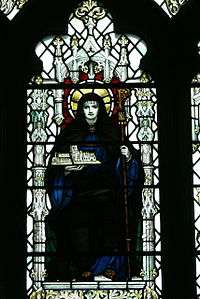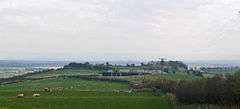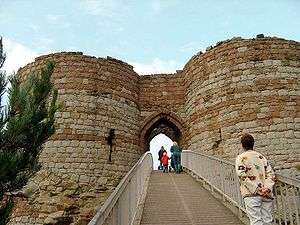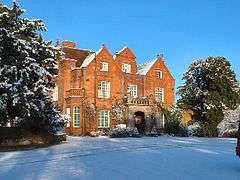Timeline of Cheshire history
The timeline of Cheshire history shows significant events in the history of the English county of Cheshire.
1–500 AD
.jpg)
Model of Deva Victrix
- 70: The Romans found the fortress and town of Deva Victrix, now Chester.[1]
- c. 90: Legio XX Valeria Victrix arrive in Chester.[2]
- 410: Romans retreat from Britannia.[1]
- 429: Germanus of Auxerre wins the Battle of Maes Garmon, near Mold, and establishes Cadell as the Christian ruler of a region, later Powys, based on pre-Roman Cornovii territory, thought to include Cheshire.[3]
7th and 8th centuries
- 603: Synod of Chester.[4]
- 616: Æthelfrith of Northumbria defeats a Welsh army at the Battle of Chester.[5]
- 689: Church of St John the Baptist founded outside Chester city walls by King Æthelred of Mercia and Bishop Wilfrid.[6]
9th century
- 874 or 875: St Werburgh's remains brought to Chester for protection against Danish invaders.[7][8]
- c. 890: Chester establishes a mint.[8]
- 890: Plegmund, probably of Plemstall, becomes Archbishop of Canterbury.[9]
- 893: First mention of Scandinavian settlers in Chester.[10]
- 893–894: A Danish force overwinters in Chester.[11]
- 894–895: King Alfred drives the Danes from Chester.[12]
10th century
- 907: Chester refounded as a burh by Æthelflæd and King Edward the Elder, and re-fortification starts.[13][14]
- 907: Church to St Werburgh, later Chester Cathedral, founded by Æthelflæd, rebuilt from an earlier church dedicated to St Peter and St Paul.[7][15]
- 907: Æthelflæd founds new church dedicated to St Peter and St Paul in Chester.[15]
- 914: The Iron Age hill fort at Eddisbury is re-fortified by Æthelflæd.[16]
- 915: Æthelflæd builds a burh at Runcorn.[17]
- 915–920: Re-fortification of Chester probably completed.[8]
- 919: Edward the Elder builds a burh at Thelwall.[18]
- 923–924: Chester revolts against rule from Wessex and is subdued by Edward the Elder.[18]
- 17 July 924: Edward the Elder dies at Farndon[19] or Aldford.[18]
- 937: King Æthelstan defeats the armies of Dublin, Alba and Strathclyde at the Battle of Brunanburh, probably near Bromborough.[20]
- 958: King Edgar of England grants a charter to St Werburgh's Abbey, Chester.[21]
- 973: Edgar of England visits Chester.[22]
- 980: Vikings raid Chester.[23]
- 980: First recorded use of the shire or county of Chester.[24]
11th century
- 1007: Eadric Streona becomes the King's ealdorman of Mercia.[25][26]
- 1016: Edmund Ironside ravages Chester.[23]
- c. 1017: King Cnut executes Eadric Streona, and makes Leofric Earl of Mercia.[25]
- 1062: Edwin succeeds as Earl of Mercia.[27]
- 1069–1071: William I leads the Norman Conquest into Cheshire; besieges Chester and kills Edwin, Earl of Mercia.
- 1070: Hugh d'Avranches created as first Earl of Chester.[28]
- 1070: Chester Castle built.[29]
- 1070: Frodsham Castle built.[30]
- 1075: St John the Baptist's Church, Chester becomes a cathedral.[31]
- 1092: Monastery founded on site of current Chester Cathedral by Hugh d'Avranches.[7]
12th century

Remains of Norton Priory
- 1115: Norton Priory founded.[32]
- 1133: Combermere Abbey founded.[33]
- 1140: Serious fire in Chester.[34]
- c. 1150: Ranulf de Gernon, 4th Earl of Chester founds a Benedictine nunnery in Chester.[35]
- 1157: Henry II entertained at Chester Castle.[36]
- 1165: Henry II entertained at Chester Castle again.[36]
- 1180: Serious fire in Chester.[34]
- 1182: Cheshire land north of the Mersey becomes part of the new county of Lancashire.
- 1190: Ranulf de Blondeville, 6th Earl of Chester founds Little St John's Hospital in Chester.[37]
- c. 1195: Liber de Luciani laude Cestrie, the oldest surviving piece of Cheshire writing, was created.[38]
13th century
- 1211: King John entertained at Chester Castle.[36]
- 1215–16: In the Carta Communis Cestriensis, Ranulf de Blondeville, 6th Earl of Chester grants limited concessions to his feudal lords.[39]
- 1220s: Beeston Castle built.[40]
- 1236: Dominican friars arrive in Chester.[34]
- 1237: 7th Earl of Chester, John, dies without a male heir. Henry IV passes the title to his son, Prince Edward – later to become King Edward I.
- 1237–38: Franciscan friars arrive in Chester.[34]
- 1237–51: Stone walls replace the wooden palisade around Chester Castle.[41]
- 1253: Aldford and Alderley markets created.[42]
- 1261: Macclesfield market created.[42]
- 1272: Congleton market created.[42]
- 1275: Monks of St Werburgh's Abbey build Kaleyard Gate in Chester city walls.[43]
- 1277: King Edward I lays foundation stone to Vale Royal Abbey.[44]
- 12 May 1278: Serious fire in Chester when nearly the whole of the city is burnt.[34]
- 1279–80: Timber superstructure of the Old Dee Bridge swept away.[45]
- 1280: Over market created.[42]
- 1281: Serious fire in Middlewich.[46]
- 1292–93: Chambers for the king and queen, and a new outer gatehouse built at Chester Castle.[47]
14th century
- 1306: Serious fire in Northwich.[46]
- 1322–25: Chester Water Tower built.[48]
- 1349: The black death arrives in Cheshire.[37][49]
- 1364: Doddington Castle built.[50]
- 20 July 1376: Charter of disafforestation of Wirral issued.[51]
- 1387: Major repairs to the Old Dee Bridge.[45]
- 1391: Norton Priory becomes a mitred abbey.[52]
- 1394: Richard II visits Chester with many of his nobles.[53]
- 1397: Lands in the march of Wales added to Cheshire, and it is promoted to the rank of principality.[54]
- 16 October 1398: Richard II gives 3000 marks to his Cheshire supporters at the Battle of Radcot Bridge.[55]
- 1399: Henry IV (then still Duke of Lancaster) seizes Chester Castle and causes Richard II to be brought there from Flint Castle, after which Richard abdicates and Henry becomes king.[56]
- 1399–1407: Tower built to fortify Chester's Dee Bridge.[57]
15th century
- 1400: Unsuccessful attack on Chester Castle by supporters of deposed Richard II.[58]
- July 1403: Many Cheshire gentry support the unsuccessful uprising of Henry "Hotspur" Percy against Henry IV.[59]
- 1422: First reference to Chester Mystery Plays.[60]
- 1433: Famine led to food shortages in Chester.[53]
- July 1438: Serious fire in Nantwich.[46]
- 1444: Henry VI visits Chester.[53]
- 1445: Fee-farm (rent payable to the Crown) for Chester is halved from £100 to £50, attributed to silting of the River Dee; further reductions agreed in 1484 and 1486.[61]
- 1450: A group of Cheshire gentry successfully petitions the Crown against the introduction of a parliamentary subsidy.[62]
- 1452, 1455, 1459: Margaret of Anjou visits Chester.[53][63]
- 23 September 1459: Many Cheshire gentry killed fighting on both sides in the Battle of Blore Heath, early in the Wars of the Roses.[64]
- 1470: Edward IV visits Chester.[53]
- April 1484: Richard III visits Chester.[53]
- March 1486: Henry VII visits Chester.[53]
- 1488: Stockport Grammar School is founded.[65]
- 1492, 1494: Fires in Chester's Foregate and Northgate Streets.[66]
- July 1493: Henry VII again visits Chester.[53]
- 1497: First performance of Chester Midsummer Show.[67]
16th century
- 1502: Macclesfield Grammar School is founded.[68]
- 1506: Great Charter establishes Chester as a county, codifies its government, and gives the city the right to hold a court of quarter sessions.[69]
- April 1506: Henry VII visits Chester.[53]
- 1507: Outbreak of "sweating sickness" in Chester.[53]
- 1510: St Ursula's Hospital founded in Chester.[37]
- 1527: Malpas Grammar School founded.[70]
- 1535: Outbreak of plague in Nantwich.[46]
- 1536: Dissolution of Norton Priory.[71]
- 1536: First piped water supply for civil use in Chester established.[66]
- 1538: Dissolution of Vale Royal Abbey by Sir Thomas Holcroft.[44]
- July 1538: Dissolution of Combermere Abbey.[33]
- 15 August 1538: Dissolution of Chester's three friaries.[72]
- 20 January 1540: Dissolution of St Werburgh's Abbey.[72]
- 1541: St Werburgh's abbey becomes a cathedral of the Church of England known as Chester Cathedral by order of King Henry VIII. Chester becomes a diocese.[73]
- 1543: Cheshire sends its first members to sit in Parliament.[74]
- 1575: Chester Mystery Plays are banned.[67]
- 1577: Christopher Saxton publishes his map of Cheshire.[75]
- 1578: Sandbach market opens.[76]
- December 1583: Fire destroys much of Nantwich.[77]
- 1584: Elizabeth I contributes to a national fund for the rebuilding of Nantwich.[78][79]
- 1591: Stanley Palace built in Chester on the site of the former Dominican friary.[80]
17th century
- 1604: Outbreak of the plague kills around 500 people in Nantwich.[81]
- 1636: Completion of Crewe Hall.[82]
- 1637: First known stagecoach runs between Birmingham and Holywell via Nantwich and Chester.[83]
- 1642: Failure of the Bunbury Agreement, an attempt by local gentry to keep Cheshire neutral in the English Civil War.[84]
- 23–28 September 1642: Charles I in Chester.[85]
- 13 March 1643: First Battle of Middlewich in English Civil War.[86]
- 24 January 1644: Battle of Nantwich in the English Civil War.[87]
- November 1644–February 1645: Siege of Chester.[88]
- 24 September 1645: Battle of Rowton Heath in the English Civil War.[89]
- 3 February 1646: Chester surrenders to the Parliamentary forces.[90]
- 21 October 1650: First record of the Cheshire cheese trade with London.[91]
- 1655: Cheshire under military rule, governed by Charles Worsley.[92]
- 1657: Stagecoach service begins between London and Chester.[83]
- 1670: Smith-Barry family re-discovers salt in Northwich and mining restarts.[93]
- 1674: John Ray's Collection of English Words includes written record of the Cheshire dialect.[94]
- 1687: James II visits Chester.[95]
- 6 June 1690: William III stays at Combermere Abbey on his way to the Battle of the Boyne.[33]
18th century
- 1700: Brine springs are discovered at Winsford.[96]
- 1735–36: The New Cut dug along the River Dee from Chester to Connah's Quay because of silting of the river.[97]
- 1744: Charles Roe builds a watermill in Macclesfield and triggers start of the silk industry.
- 1763: Cheshire Hunt founded.[98]
- March 1776: Bridgewater Canal complete throughout its length from Manchester to Runcorn.[99]
- 1777: Completion of the Trent and Mersey Canal.[100]
- 1779: The Chester Canal opens between Chester and Nantwich.[101]
- 1780: Chester Eastgate rebuilt.[102]
- 1780: Marston salt mine opens.[103]
- 1781: Chester Northgate rebuilt.[102]
- 1784: First mail coach runs through Cheshire, between London and Holyhead.[83]
- 1788: Chester Watergate rebuilt.[102]
- 1788–1815: Major rebuilding of Chester Castle by Thomas Harrison[104]
- 1795: The Chester Canal extended to Ellesmere Port.[105]
19th century
- July 1804: Runcorn to Latchford Canal opens.[106]
- 1806: The Middlewich Branch opens, linking the Shropshire Union and the Trent and Mersey Canals.[105]
- 1808–10: Chester Northgate rebuilt.[102]
- 8 May 1817: Early paper on Cheshire dialect read at Society of Antiquaries by Roger Wilbraham.[107]
- 1832: The future Queen Victoria opens the Grosvenor Bridge in Chester.[108]
- 1837: Crewe railway station is built in fields near to Crewe Hall.[109]
- 1838: First meeting of the Cheshire Agricultural Society.[110]
- 1839: Foundation of Chester Diocesan Training College, now the University of Chester.[111]
- 1840: Crewe–Chester–Birkenhead railway line opens.[112]
- 1843: Crewe Railway Works opens.[113]
- 1845: Crewe Railway Works completes its first locomotive, Columbine.[113]
- 24 May 1847: Five people are killed in the Dee bridge disaster when a girder of the railway bridge crossing the River Dee fractures.[114]
- 1848: Chester railway station opens.[115]
- 1855–76: George Gilbert Scott works on restoring Chester Cathedral.[116]
- 1857: Cheshire Constabulary founded.[117]
- 1862: Chester Exchange is gutted by fire.[115]
- 1865–66: Devastating outbreak of rinderpest (cattle plague) causes the collapse of the county's economy.[118]
- 1867: Grosvenor Park opens in Chester.[119]
- 21 May 1868: The first train crosses Runcorn Railway Bridge.[120]
- 1869: Railway line opens between Weaver Junction and Liverpool via Runcorn.[121]
- 15 October 1869: Chester Town Hall opened by Prince of Wales, later King Edward VII.[122]
- 1874: John Brunner and Ludwig Mond found Brunner Mond in Winnington near Northwich and start manufacturing soda ash.[123]
- 1874: Cheshire Lines Committee opens railway line between Manchester and Chester via Altrincham.[121]
- 1875: Anderton Boat Lift opens.[124]
- 1877: Glossary of Cheshire dialect published by Egerton Leigh.[94]
- 1881: The west tower of St John the Baptist's Church, Chester collapses.[31]
- 1886: The Grosvenor Museum opens in Chester.[125]
- 1886: Rail tunnel under the River Mersey opens between Liverpool and Birkenhead.[121]
- 1889: Cheshire County Council founded.
- 21 May 1894: Manchester Ship Canal officially opened by Queen Victoria.[126]
- 27 May 1899: Official opening of Eastgate Clock in Chester on Queen Victoria's 80th birthday.[127]
20th century
- 29 May 1905: Widnes-Runcorn Transporter Bridge officially opened by Sir John Brunner.[128]
- 1921: Cheshire School of Agriculture opens at Worleston.[129]
- 1926: Imperial Chemical Industries is created.[130]
- 1931: Chester Zoo opens.[131]
- 1938: Newgate opens in Chester.[132]
- 1951: Chester Mystery Plays are revived.[133]
- 21 July 1961: Runcorn-Widnes road bridge (later named the Silver Jubilee Bridge) is opened by Princess Alexandra.[134]
- 1964: Runcorn New Town is designated.[134]
- 1969: First conservation areas designated, including Chester and Nantwich.[135]
- 1 April 1974: Cheshire boundaries changed by Local Government Act 1972.[136] Runcorn and Widnes merge to form the Borough of Halton.[134]
- 1982: Norton Priory Museum opens.[137]
- 1983: Anderton Boat Lift closes.[124]
- 26 February 1993: IRA explosive devices go off at Warrington gasworks.[138]
- 20 March 1993:: IRA explosive devices kill two children and injure 54 people in Warrington.[139]
- 1 April 1998: Halton and Warrington become unitary authorities.
21st century
- 2002: Anderton Boat Lift reopens.[124]
- 1 September 2007: The Cheshire Regiment merges into the Mercian Regiment.[140]
- 1 April 2009: Two unitary authorities of Cheshire West and Chester and Cheshire East replace Cheshire County Council and its districts.[141]
See also
Notes
- 1 2 Mason, David J.P. (2001). Roman Chester: City of the Eagles. Stroud: Tempus Publishing Ltd. ISBN 0-7524-1922-6.
- ↑ Ward 2009, p. 11.
- ↑ Bu'Lock, pp. 10–14
- ↑ Ward 2009, p. 23.
- ↑ Higham, N. J. (1992). "King Cearl, the Battle of Chester and the Origins of the Mercian 'Overkingship'" (PDF). Midland History: 1–15.
- ↑ Bu'Lock, pp. 33–34
- 1 2 3 "History of Chester Cathedral". Chester Cathedral. Retrieved 2010-05-25.
- 1 2 3 Bu'Lock, p. 59
- ↑ Wareham, A. F. (2004). "Plegemund (d. 914)" ((subscription or UK public library membership required)). Oxford Dictionary of National Biography. Oxford University Press. doi:10.1093/ref:odnb/22378. Retrieved 30 January 2013.
- ↑ Bu'Lock, pp. 69–70
- ↑ Bu'Lock, pp. 51–52, 59
- ↑ "Anglo-Saxon Chronicle (894AD)". Retrieved 2010-05-22.
- ↑ Ward 2009, p. 31.
- ↑ Bu'Lock, pp. 53, 59
- 1 2 Bu'Lock, pp. 75–76
- ↑ "Burh at Castle Ditch, Eddisbury". Cheshire.gov.uk. Retrieved 2009-07-09.
- ↑ Starkey 1990, p. 5.
- 1 2 3 Bu'Lock, pp. 53–54
- ↑ Ward 2009, p. 27.
- ↑ Bu'Lock, pp. 54–55
- ↑ Bu'Lock, p. 55
- ↑ "Edgar the Peaceful". English Monarchs website. Retrieved 2010-05-22.
- 1 2 Ward 2009, p. 30.
- ↑ Bu'Lock, pp. 56, 61
- 1 2 Bu'Lock, p. 56
- ↑ Anglo-Saxon Chronicle, 1007:
"In this year also was Edric appointed alderman over all the kingdom of the Mercians."
- ↑ Bu'Lock, p. 57
- ↑ C. P. Lewis (2004). Avranches, Hugh d', first earl of Chester (d. 1101). Oxford Dictionary of National Biography. Oxford University Press. Retrieved 2007-10-28.
- ↑ Historic England. "Chester Castle (69135)". PastScape. Retrieved 2009-03-22.
- ↑ Latham, Frank A. (1987). Frodsham: The History of a Cheshire Town. Local Historians. ISBN 0-901993-06-9.
- 1 2 Ward 2009, p. 43.
- ↑ Starkey 1990, p. 9.
- 1 2 3 "Combermere Abbey timeline". Combermere Abbey. Retrieved 2010-05-31.
- 1 2 3 4 5 Ward 2009, p. 51.
- ↑ Ward 2009, p. 46.
- 1 2 3 Ward 2009, p. 47.
- 1 2 3 Ward 2009, p. 55.
- ↑ Robert W. Barrett, Jr (2009). Against All England: Regional Identity and Cheshire Writing, 1195–1656 (PDF). University of Notre Dame Press. pp. 1–2. ISBN 978-0-268-02209-9 – via Project Muse. (subscription required (help)).
- ↑ Sylvester 1980, p. 54.
- ↑ Fry, Plantagenet Somerset (1980). The David & Charles Book of Castles. David & Charles. ISBN 0-7153-7976-3.
- ↑ Ward 2009, p. 37.
- 1 2 3 4 "Cheshire History and the County Palatine of Cheshire, UK". Manchester UK. Retrieved 2010-05-19.
- ↑ Ward 2009, p. 40.
- 1 2 Elrington, C.R.; Harris, B. E.; Baggs, A. P.; Kettle, Ann J.; Lander, S. J.; Thacker, A. T.; Wardle, David (1980). Houses of Cistercian monks: The abbey of Vale Royal', A History of the County of Chester. III. Oxford University Press History. ISBN 0-19-722754-6.
- 1 2 Ward 2009, p. 56.
- 1 2 3 4 Driver 1971, p. 50
- ↑ Ward 2009, p. 41.
- ↑ Ward 2009, p. 38.
- ↑ Sylvester 1980, p. 56.
- ↑ Historic England. "Delves Hall (74464)". PastScape. Retrieved 22 March 2009.
- ↑ Booth P. The last week of the life of Edward the Black Prince. Cambridge University Press, 2012
- ↑ Greene 1989, p. 65
- 1 2 3 4 5 6 7 8 9 10 Driver 1971, p. 38
- ↑ Davies, R. R. (1971). Richard II and the Principality of Chester in The Reign of Richard II: Essays in Honour of May McKisack, ed. F. R. H. Du Boulay and Caroline Baron.
- ↑ Driver 1971, p. 7.
- ↑ Ward 2009, p. 42.
- ↑ Driver 1971, p. 54.
- ↑ Driver 1971, pp. 8–9
- ↑ Driver 1971, pp. 9–10
- ↑ Driver 1971, p. 140
- ↑ Driver 1971, pp. 39–40, 106
- ↑ Driver 1971, p. 117
- ↑ Driver 1971, p. 17
- ↑ Driver 1971, pp. 17–18
- ↑ Driver 1971, p. 43
- 1 2 Driver 1971, p. 31
- 1 2 Driver 1971, p. 145
- ↑ Driver 1971, p. 44
- ↑ Driver 1971, pp. 28–29
- ↑ Driver 1971, pp. 149–50
- ↑ Starkey 1990, pp. 38–39.
- 1 2 Ward 2009, p. 58.
- ↑ Driver 1971, p. 41
- ↑ Sylvester 1980, p. 15.
- ↑ Sylvester 1980, p. 60.
- ↑ Sylvester 1980, p. 52.
- ↑ Lake 1983, p. 67.
- ↑ Beck 1969, p. 75–76.
- ↑ Lake 1983, pp. 71–90.
- ↑ "Stanley Palace". Chester City Council. Retrieved 18 June 2010.
- ↑ Beck 1969, p. 33.
- ↑ "Crewe Hall". English Heritage. Retrieved 2010-06-17.
- 1 2 3 Sylvester 1980, p. 83.
- ↑ "Civil War". National Archives. Retrieved 2010-05-22.
- ↑ Ward 2009, p. 64.
- ↑ J. R. Phillips (1874). Battle of Middlewich, March 13, 1643 – Sir William Brereton's Account. Document XVI in Memoirs of The Civil Wars in Wales and the Marches, Vol 2. London. pp. 54–55.
- ↑ "Battle of Nantwich". Nantwich Museum. Retrieved 2010-05-31.
- ↑ Ward 2009, pp. 67–68.
- ↑ Ward 2009, p. 69.
- ↑ Sylvester 1980, p. 69.
- ↑ Edwards P (1999), "Cheshire Cheese and Farming in the North West in the Seventeenth and Eighteenth Centuries by Charles F. Foster [Book review]", The Agricultural History Review, 47: 217–18, (registration required (help))
- ↑ "Charles Worsley, Major-General, 1622–56". British Civil Wars & Commonwealth website. Retrieved 2010-05-22.
- ↑ "Northwich History". Chester Chronicle. February 2009. Retrieved 2010-05-25.
- 1 2 Leigh E. Introduction in: A Glossary of Words Used in the Dialect of Cheshire (Hamilton, Adams, and Co./Minshull and Hughes; 1877) (accessed 14 July 2010)
- ↑ Ward 2009, p. 73.
- ↑ Sylvester 1980, p. 95.
- ↑ Ward 2009, p. 82.
- ↑ "The Cheshire Hunt". The Cheshire Hunt website. Retrieved 2010-05-31.
- ↑ Starkey 1990, p. 126.
- ↑ "Trent and Mersey Canal". Cannock Chase District Council. Retrieved 2010-05-22.
- ↑ Ward 2009, p. 88.
- 1 2 3 4 Ward 2009, p. 79.
- ↑ Sylvester 1980, p. 96.
- ↑ Ward 2009, pp. 80–81.
- 1 2 Ward 2009, p. 89.
- ↑ Starkey 1990, p. 130.
- ↑ Wilbraham R. An Attempt at a Glossary of Some Words Used in Cheshire, 2nd edn (T. Rood; 1826)
- ↑ Ward 2009, p. 86.
- ↑ Glancey, Jonathan (6 December 2005). "The beauty of Crewe". Guardian newspaper article. London. Retrieved 2007-08-07.
- ↑ Latham, ed., 1999, p. 119
- ↑ Dunn I, The University of Chester, 1839–2008: The Bright Star in the Present Prospect, 2nd edn (Chester: Chester Academic Press, 2008)
- ↑ Sylvester 1980, p. 90.
- 1 2 Sylvester 1980, p. 91.
- ↑ Ward 2009, pp. 90–91.
- 1 2 Ward 2009, p. 91.
- ↑ Ward 2009, p. 92.
- ↑ "Cheshire Constabulary History". Cheshire Police website. March 2010. Retrieved 2010-05-24.
- ↑ Matthews S (2005), "Cattle Clubs, Insurance and Plague in the Mid-Nineteenth Century", The Agricultural History Review, 53: 192–211, JSTOR 40276026, (registration required (help))
- ↑ Ward 2009, p. 95.
- ↑ Starkey 1990, p. 170.
- 1 2 3 Sylvester 1980, p. 93.
- ↑ "Chester Town Hall". Cheshire West and Chester Council. Retrieved 2010-05-31.
- ↑ "History of Brunner Mond". Brunner Mond website. Retrieved 2008-09-02.
- 1 2 3 "Anderton Boat Lift". The Heritage Trail website. Retrieved 2010-05-31.
- ↑ Ward 2009, p. 99.
- ↑ "Lancashire Records Office". The National Archives.
- ↑ "Information Sheet: Eastgate Clock". Cheshire West and Chester. Retrieved 18 June 2010.
- ↑ Starkey 1990, p. 214.
- ↑ Tigwell 1985, pp. 41–42.
- ↑ Starkey 1990, p. 218.
- ↑ "Chester Zoo". The Good Zoo Guide Online. Retrieved 2010-06-17.
- ↑ Ward 2009, p. 111.
- ↑ Robert W. Barrett, Jr (2009). Against All England: Regional Identity and Cheshire Writing, 1195–1656 (PDF). University of Notre Dame Press. p. 207. ISBN 978-0-268-02209-9 – via Project Muse. (subscription required (help)).
- 1 2 3 Starkey 1990, p. 222.
- ↑ "Conservation Area Appraisals". Cheshire East. Retrieved 2010-06-16.
- ↑ Jones, B.; et al. (2004). Politics UK. ISBN 0-7190-3408-6.
- ↑ Brown, Fraser; Howard-Davis, Christine (2008). Norton Priory: Monastery to Museum. Excavations 1970–87. Lancaster: Oxford Archaeology North. pp. 2–4. ISBN 978-0-904220-52-0.
- ↑ "Bound Volume Hansard - Written Answers". Hansard. Retrieved 2010-05-31.
- ↑ "Child killed in Warrington bomb attack". BBC website. 20 March 1993. Retrieved 2010-05-31.
- ↑ "Three infantry regiments merged (1 September 2007)". BBC. 1 September 2007. Retrieved 2010-06-10.
- ↑ "About Cheshire East". Cheshire East. Archived from the original on July 27, 2011. Retrieved 7 July 2010.
References
- Beck, J. (1969). Tudor Cheshire. A History of Cheshire, Vol. 7 (Series Editor: J.J. Bagley), Cheshire Community Council, ISBN 0-903119-02-1
- Bu'Lock, J.D. (1972). Pre-Conquest Cheshire: 383–1066. A History of Cheshire, Vol. 3 (Series Editor: J.J. Bagley), Cheshire Community Council
- Driver, J.T. (1971). Cheshire in the Later Middle Ages. A History of Cheshire, Vol. 6 (Series Editor: J.J. Bagley), Cheshire Community Council
- Greene, J. Patrick (1989). Norton Priory: The archaeology of a medieval religious house. Cambridge: Cambridge University Press. ISBN 0-521-33054-8.
- Lake, J. (1983). The Great Fire of Nantwich. Shiva Publishing. ISBN 0-906812-57-7.
- Local History Group, Latham FA. (ed.) (1999). Wrenbury and Marbury. The Local History Group. ISBN 0-9522284-5-9
- Starkey, H. F. (1990). "Old Runcorn". Halton: Halton Borough Council.
- Sylvester, Dorothy (1980). A History of Cheshire (2nd ed.). London and Chichester: Phillimore. ISBN 0-85033-384-9.
- Tigwell, RE. (1985). Cheshire in the Twentieth Century. A History of Cheshire, Vol. 12 (Series Editor: JJ Bagley), Cheshire Community Council, ISBN 0-903119-15-3
- Ward, Simon (2009). Chester: A History. Chichester: Phillimore. ISBN 978-1-86077-499-7.
Coordinates: 53°10′N 2°35′W / 53.167°N 2.583°W
This article is issued from Wikipedia - version of the 11/14/2016. The text is available under the Creative Commons Attribution/Share Alike but additional terms may apply for the media files.




.jpg)


.svg.png)